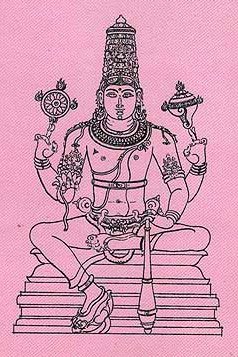Varnotpattinirupana, Varṇotpattinirūpaṇa, Varnotpatti-nirupana: 2 definitions
Introduction:
Varnotpattinirupana means something in Hinduism, Sanskrit. If you want to know the exact meaning, history, etymology or English translation of this term then check out the descriptions on this page. Add your comment or reference to a book if you want to contribute to this summary article.
In Hinduism
Pancaratra (worship of Nārāyaṇa)
Source: Wisdom Library: PāñcarātraVarṇotpattinirūpaṇa (वर्णोत्पत्तिनिरूपण) [=varṇotpattinirūpaṇam] is the name of the sixteenth chapter of the Ahirbudhnyasaṃhitā: an ancient Pāñcarātra Āgama scripture dealing with the symbology of the Sudarśana weapon while also dealing with iconography, philosophy and Vaiṣṇava rituals.
Source: archive.org: Catalogue of Pancaratra Agama TextsVarṇotpattinirūpaṇa (वर्णोत्पत्तिनिरूपण) (lit. “regarding origin of letters”) is the name of the sixteenth chapter of the Ahirbudhnyasaṃhitā, a Pāñcarātra work in 60 chapters dealing with topics such as Viṣṇu’s discus-power, the processes of creation and esoteric practices related to Sudarśana (such as mantras and yantras).
Description of the chapter [varṇotpattinirūpaṇa]: Nārada asks how all things in creation, being as they are, can be protected, and he is answered that the Lord Himself wills to protect all things by means of His energies as Sudarśana in whom are invested the necessary weapons of protection (astra/śastra). Not only are there the ordinary weapons analogous to God’s own which serve to protect man, but there is the mystical weapon in the form of “mantra” that can protect man and the world (1-9). Only the competent, however, may receive the mystical mantra—and this means only the best among Brahmins—while at the same time only the king can wield appropriately the ordinary weapons. When an extraordinary Brahmin with his astra-mystical weapons and an extraordinary ruler with his complement of regular śastra-weapons combine forces, the kingdom prospers (1-36 ).
As for the mantra-weapon of protection, there is a long and highly involved and technical exposition of how sounds have their potencies, and syllables are combinations of these, etc. Each letter of the alphabet is analysed as to its physiological locus, its cosmic origin, etc. (37-104).

Pancaratra (पाञ्चरात्र, pāñcarātra) represents a tradition of Hinduism where Narayana is revered and worshipped. Closeley related to Vaishnavism, the Pancaratra literature includes various Agamas and tantras incorporating many Vaishnava philosophies.
See also (Relevant definitions)
Partial matches: Varnotpatti, Nirupana.
Full-text: Varnotpatti.
Relevant text
No search results for Varnotpattinirupana, Varṇotpattinirūpaṇa, Varṇotpatti-nirūpaṇa, Varnotpatti-nirupana; (plurals include: Varnotpattinirupanas, Varṇotpattinirūpaṇas, nirūpaṇas, nirupanas) in any book or story.